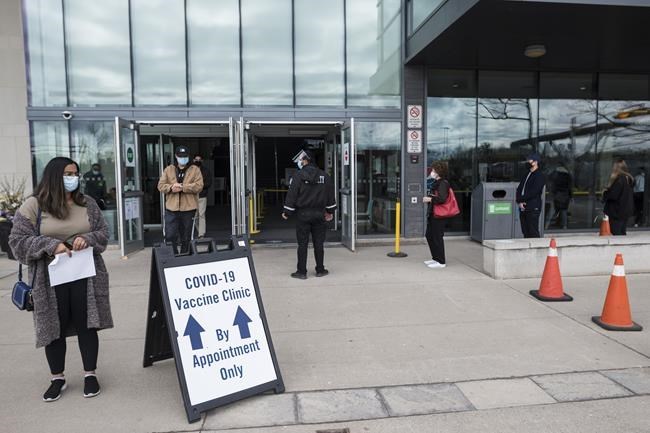Canada's most populous provinces showed promising signs of containing their COVID-19 cases Thursday, as pandemic urgency shifted to surges in Alberta and Nova Scotia and efforts to vaccinate teens before the next school year.
Ontario reported 3,424 new cases and 26 more deaths linked to the virus. While that's an increase from 2,941 reported Wednesday, the province's seven-day average dropped to 3,369 from a record-high 4,348 on April 19.
The slight levelling off came as the province said it had administered a record 141,000 vaccines Wednesday, while over in Quebec, Health Minister Christian Dubé noted declines in case counts, hospitalizations and test positivity rates were pushing his province "in the right direction."
Hospitalizations there dropped by eight, to 580, and 144 people were in intensive care, a decrease of eight.
Eyes remained on Nova Scotia, however, where an alarming upswing pushed daily counts to a pandemic high of 182 Thursday, following a 175-case tally a day before.
Alberta, meanwhile, reported 2,211 cases, as the province waited to see whether new containment measures announced early this week would make a difference.
Vaccine strategy and lockdown measures are playing a role in Ontario's dropping daily average, infectious disease doctor Zain Chagla said in an interview.
And promising provincial data on vaccine effectiveness may give other jurisdictions hope things can turn around quickly, especially if inoculations are prioritized to those who need them most.
"The big thing now is vaccinating people in places where density of transmission is high," Chagla said.
"So having that mentality of, we're not only vaccinating to a particular age but scaling vaccines in populations that have been hit hard throughout this pandemic."
Dr. Howard Njoo, Canada's deputy chief public health officer, said "vaccines alone are not the silver bullet" to easing spread in Alberta, which has seen skyrocketing infection rates and a health-care system that's "beginning to be overloaded."
He said "strong public health measures" are also necessary.
Nova Scotia, which was mostly spared by COVID-19 earlier in the pandemic, added new restrictive measures last week, including a $2,000 fine for anyone caught leaving their counties for non-essential reasons.
Premier Iain Rankin said he was "frustrated" by his province's rising case numbers.
"I don't know what more I can say to Nova Scotians to make sure they take this issue seriously," he said.
British Columbia's infection rate has remained below 700 since Sunday after surging before new restrictions were introduced in late March.
The province reported its first case of a blood clot connected to the Oxford-AstraZeneca vaccine on Thursday. A woman in her 50s is in hospital after her doctor recognized the symptoms of the rare condition.
Quebec reported 907 new cases Thursday, along with seven more deaths attributed to the virus.
Nunavut reported 12 new infections, all in the 8,000-population capital of Iqaluit, with chief public health officer Dr. Michael Patterson saying house parties were to blame.
Data released by Public Health Ontario this week showed how effective Canada's approved COVID-19 vaccines have been.
The agency found that from Dec. 14, 2020 — the beginning of the rollout — to April 17, 2,223 people tested positive for COVID-19 out of almost 3.5 million people vaccinated with at least one dose in Ontario.
Ontario says it expects 65 per cent of adults to have their first dose by the end of May, and eligibility could soon open to teens following Health Canada's authorization of the Pfizer-BioNTech jab in 12-to-15-year-olds on Wednesday.
Other provinces are making similar plans.
As of Thursday afternoon, Canada had given at least one dose to 13.7 million people, leaving just under 20 million people, over the age of 12, still without their first dose. Canada is currently expecting 10.8 million doses in May: 8.1 million Pfizer (including this week’s delivery), 2.1 million Moderna (including this week’s delivery) and 655,000 of AstraZeneca from COVAX.
In June, the projections are for 13.1 million doses, with the expectation of another six to eight million doses from Moderna on top of that. The 13.1 million includes 12.1 million doses of Pfizer and one million AstraZeneca.
Dubé said he's waiting for details on a formal plan but said Quebec youth between 12 and 17 can expect to be offered a vaccine by the end of June and to be fully vaccinated by the time they return to school in September.
Dr. Anna Banerji, a pediatrician and infectious disease expert with the University of Toronto, said vaccinating teens marks an important step in Canada's rollout.
"Just having adults immunized is not enough to get to that herd immunity point," Banerji said.
While kids are less likely to suffer severe disease from a COVID infection, Banerji said they have played a role in spreading the virus.
Canada achieved a new milestone in its vaccination program this week, surpassing the vaccination rate in the United States for the first time.
The Our World in Data project, which tracks vaccinations around the world, says the United States injected doses at a rate of 6.4 doses for every 1,000 people Wednesday. Canada injected 6.6 doses for every 1,000 people.
Canada had vaccinated more than 14.5 million people with at least one dose as of Thursday, which represents 41 per cent of the adult population.
Njoo said he believes there's a "new energy" and "new optimism" around the country's rollout.
"The overall goal has always been to vaccinate as many eligible Canadians as soon as possible," he said. "So I think we're on track and I think it bodes well for the summer."
This report by The Canadian Press was first published May 6, 2021.
Melissa Couto Zuber, The Canadian Press




